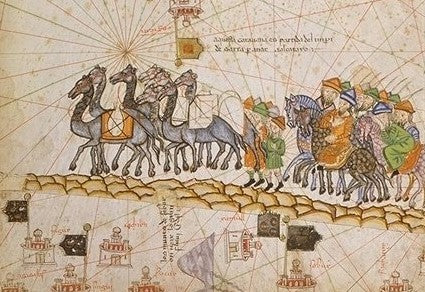
The Story of the Silk Road
The history of silk development spans through centuries and can be traced around the world’s very ancient trade route called the ‘Silk Road’. It began in China, passed through Tashkent, Baghdad, Damascus, Istanbul to reach European shores. Since the beginning of the Christian era (by 126 BC) silk has been the most colourful of the world’s caravans. Fabulous silks from China and India were carried to Europe through this 6400 km Silk Road.

The Silk Road originated in Sian, followed the Great Wall of China to the north-west, bypassed the Takla Makan Desert rose over the Pamir Mountains, crossed Afghanistan and went on to Levant, from there the cargo was shipped to Europe across the Mediterranean. Marco Polo journeyed through this highway during the 13th century to reach the Asian lands.

It seems China kept secret of silk for centuries and traded silk against gold with affluent Western monarchs. But Chinese emigrants smuggled silk cultivation into Korea from where the silkworms slipped into Japan, which eventually became top producer of silk. Sericulture entered Europe during 140-86 BC.
I can see clothes of silk, if materials that do not hide the body, nor even one's decency, can be called clothes... Wretched flocks of maids labour so that the adulteress may be visible through her thin dress, so that her husband has no more acquaintance than any outsider or foreigner with his wife's body.
– Seneca the Younger (c. 3 BCE – 65 CE), Declamations Vol. I

India has an equally long 3000-year history of silk development and at present ranks second to China in multi-varieties of silk production. Europe developed sericulture before the Industrial Revolution but later with pebrine disease destroying the crop, took to silk processing and weaving where it excelled. The new world – America – started cultivating silk in place of tobacco in Virginia during early 17th century.
Transmission of good and ideas
Nomadic mobility played a key role in facilitating inter-regional contacts and cultural exchanges along the ancient Silk Roads. Trading activities along the Silk Road over many centuries facilitated the transmission not just of goods but also ideas and culture, notably in the area of religions. Zoroastrianism, Judaism, Buddhism, Christianity, Manichaeism, and Islam all spread across Eurasia through trade networks that were tied to specific religious communities. Notably, established Buddhist monasteries along the Silk Road offered a haven, as well as a new religion for foreigners.

New Silk Road
After an earthquake that hit Tashkent in Central Asia in 1966, the city had to rebuild itself. Although it took a huge toll on their markets, this commenced a revival of modern silk road cities.
The Eurasian Land Bridge (a railway through China, Kazakhstan, Mongolia and Russia) is sometimes referred to as the "New Silk Road". The last link in one of these two railway routes was completed in 1990. In 2008 the line was used to connect the cities of Ürümqi in China's Xinjiang Province to Almaty and Astana in Kazakhstan. In October 2008 the first Trans-Eurasia Logistics train reached Hamburg from Xiangtan. Starting in July 2011 the line has been used by a freight service that connects Chongqing, China with Duisburg, Germany, cutting travel time for cargo from about 36 days by container ship to just 13 days by freight train. Last year the service sent its first train to London and now also connects to Madrid and Milan.
Belt and Road Initiative
In September 2013, during a visit to Kazakhstan, Chinese President Xi Jinping introduced a plan for a New Silk Road from China to Europe. The latest iterations of this plan, dubbed the "Belt and Road Initiative" (BRI), includes a land-based Silk Road Economic Belt and a 21st Century Maritime Silk Road, with a number of logistics and transshipment hubs in Europe.
On 22 June 2014, the United Nations Educational, Scientific and Cultural Organization (UNESCO) named the Silk Road a World Heritage Site at the 2014 Conference on World Heritage. The United Nations World Tourism Organization has been working since 1993 to develop sustainable international tourism along the route with the stated goal of fostering peace and understanding.
References:
https://en.wikipedia.org/wiki/Silk_Road
Gobal Silk Industry – A complete Source Book - by Rajat. K. Datta & Mahesh Nanvaty
